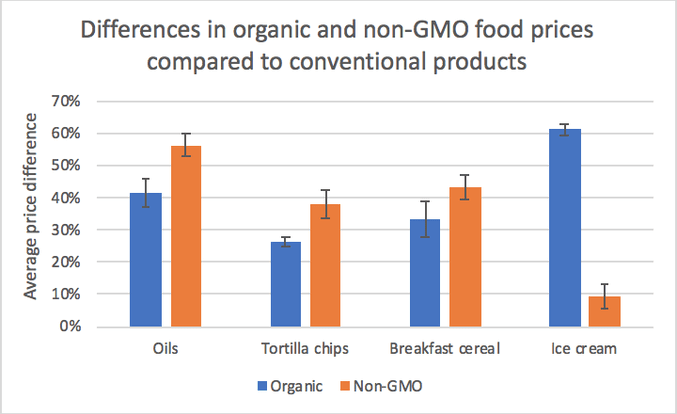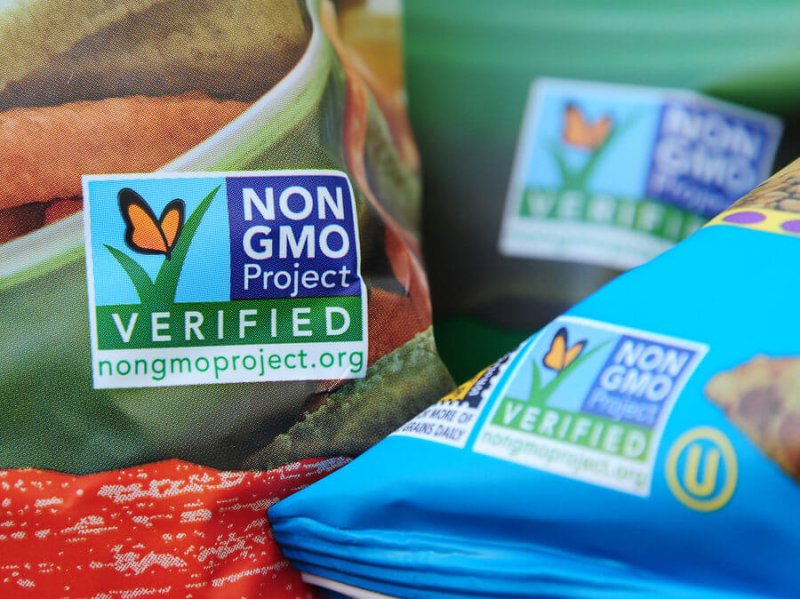For all the lingering question marks surrounding implementation, however, a new study suggests one potential outcome of the new labeling regime is straightforward: If manufacturers choose to switch to non-GM ingredients in order to dodge any stigma among consumers, the cost of food is likely to rise — and the price hike could prove more burdensome for low-income people and those who mainly eat at home.
The finding is based on a statistical analysis of U.S. retail price data from 2009 to 2016 on more than 10,000 non-GM, organic, and conventional food products. (Per the U.S. Department of Agriculture’s classification system, food labeled organic is non-GMO, so the researchers included products with either of those designations.) The study involved laboriously tracing the incremental costs for each ingredient in each product in order to pin down the factors causing the price changes in goods.
Compared with conventional versions of ice cream, breakfast cereal, tortilla chips, and cooking and salad oils, consumers paid a non-GM price premium of 10 percent, 26 percent, 24 percent, and 62 percent, respectively, according to the study, which was published March 21 in the journal Food Policy. These figures are at least 10 times higher than some previous estimates of the impact of mandatory GM labeling, the researchers wrote.

Less processed foods or products with a relatively high share of source crops tended to have the heftiest price premiums. This could have a significant impact on the budgets of lower-income consumers, who are more likely than higher-income consumers to buy ingredients for cooking meals at home, the researchers wrote.
“Because lower-income people tend to buy foods with less added value, if those foods are disproportionately more expensive, as we found, then obviously the people who buy them are disproportionately affected by the incremental costs,” says study leader Nicholas Kalaitzandonakes, an agricultural economist at the University of Missouri.
This impact on consumers has not been considered by researchers and policymakers, but it should be, he adds. Instead, much of the debate on GM foods and labeling in the U.S. and Europe has dealt with unfounded human health concerns. No strong evidence to date has shown that GM foods are any less safe than non-GM foods. In 2012, the board of directors of the American Association for the Advancement of Science released a statement opposing mandatory labeling.
The new research was funded by the United Soybean Board, an industry-funded program that represents farmers who grow conventional, non-GM and/or organic soybeans and supports research on the crop. The Board influenced neither how the study was performed nor the analysis, Kalaitzandonakes says.
 The price premiums were stable over the eight-year period studied, he says, which suggests that consumers felt the price hike consistently even as more non-GM and organic food was sold in markets over time. So, increasing volume did not result in lower costs or price premiums.
The price premiums were stable over the eight-year period studied, he says, which suggests that consumers felt the price hike consistently even as more non-GM and organic food was sold in markets over time. So, increasing volume did not result in lower costs or price premiums.
If most manufacturers of products that currently contain GM ingredients choose simply to add the label rather than to reformulate their product with more expensive non-GM ingredients, consumers would likely see less of a hike in food costs once the law is fully in place.
In any case, Kalaitzandonakes favors plurality in the marketplace.
“Consumers should have the opportunity to go to the market and vote with their wallets, and if consumers choose to buy more organic foods and they choose to buy more non-GM foods, you will see many more of those in the marketplace, because food suppliers want to supply those,” he says. “They want to be in a profitable business.”
Robin Lloyd is a senior writer at Undark and a contributing editor at Scientific American. Follow her on Twitter @robinlloyd99. 
This article was originally published at Undark as “GM Food Labels Could Burden Low-Income Consumers” and has been republished here with permission.































